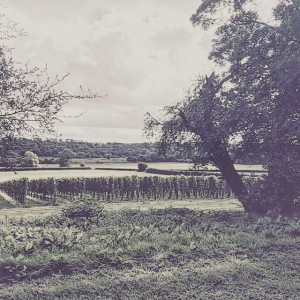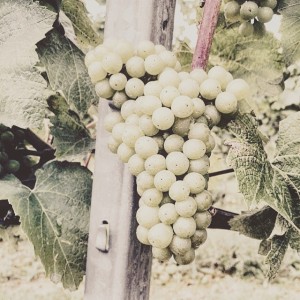Recently, I took a trip to London and I wanted to take a couple of days to check out the vineyards in the English countryside. English sparkling wine has become a new, exciting development in the UK, but it is still seen as an anomaly in the US. I think this is interesting because we think of the UK as being a much more well-established wine drinking country than the US, but as a wine producing country, they are just starting to find their specialty: sparkling wine.
I was lucky enough to spend the day checking out the vineyards and facilities of Hattingley Valley in Hampshire, Southern England. They have won many prestigious awards over the past couple of years – pretty impressive considering they have only been established since 2008.
In a world where Champagne dominates as the premium and ultra premium sparkling wine of choice on the international wine scene, there seems to be an outcry for another high quality option from another country.
What about other popular “Champagne-like” sparkling wines on the US market?
There is Cava from Catalunya, Spain. But Cava has built their international image on value and hence, their quality is limited by the fact that there is price sensitivity when it comes to their wines.
Yes, I know there are some high quality examples of Cava, but I think it is fair to say that many are a simpler version of Champagne.
The sparkling wines of Northern California and Franciacorta in Lombardy, Italy both have high quality offerings that can rival Champagne but they do not have the fierce backbone of acidity that makes Champagne thrilling to some and, conversely, too austere for others.
I love having a Franciacorta or California sparkler when I want a little more fruit and rounder body. Also, I find they are a much friendlier choice when buying “Champagne-look-alikes” for a mixed crowd of wine drinkers.
It is interesting to note that Champagne is producing riper grapes which are evident in many vintage Champagnes that have been released over the past decade. Some producers, such as Lanson, are promoting the fact that they do not allow the wine to go through malolactic fermentation (which keeps the acidity high and sharp) and represents a more “traditional” style of Champagne.
Today, Champagne vintages are two weeks earlier than twenty years ago – and today England typically harvests two weeks after Champagne – so perhaps one can conclude that England is what Champagne was several decades ago.
I know it is not that simple. England has a lot less sun and a lot more rain than Champagne has ever had in recent history. It takes a tremendous amount of work to harvest balanced, healthy grapes. During my visit, I kept asking the question of what was the biggest difference between making traditional sparkling wine in Champagne vs England, and the answer I was given was the same: it is easier in Champagne.
This was evident at Hattingley Valley in Hampshire. The 2014 vintage was a “great” one for English sparkling wine but 2015 has been a very difficult vintage. All the vineyards showed many footprints that indicated a vineyard team that kept a close eye on their vines. It comes down to a significant amount of man hours preventing disease (biggest problem is botrytis) and opening up the canopy to expose the grapes to the maximum amount of air and light.
A tough vintage does not always translate into a bad vintage, but it does translate into more work. And there are a handful of producers who have the heart and desire to make top quality wine; Hattingley Valley being one of those special producers who are investing a large amount into the best equipment and best people. They are doing it right from the beginning, they are not just making sparkling wine that is “good considering it is from England”, they want to make a range of good to great wines that will be compared to the top regions of the world.
Even in a tough vintage, their top vineyards had Chardonnay bunches that looked and felt perfect when I walked through a couple weeks ago. Yes, I did see millerandage, aka hens and chicks (different size berries in bunches), in other vineyards but many of the grapes had softened and were showing veraison (change of color) which was a good sign at that stage.
The major test always comes down to tasting the wines. I was first introduced to English sparkling wines eight years ago. My impression at that time was that they were thin and too acidic. But Nyetimber and Hattingley Valley have been the two big exceptions in my tasting experience. Their sparkling wines are complex and balanced. Emma Rice, Director and Winemaker at Hattingley Valley, is a fan of using oak to add a wonderful textural component to her wines.
The best of the English sparkling wines give a great tension of acidity and linear shape of palate that are exciting when fleshed out with a decent amount of ripeness and texture. Fierce acidity is what some connoisseurs of great Champagne crave, such as one would find in Salon, for example.
Champagne has a brand and sense of place; Hampshire, England, does not have a brand (they have only just started to get recognition with the British media and wine trade) but it certainly has a sense of place. A line of chalk runs through Hampshire, and the “Grand Cru” vineyards showed their noble pedigree with the beautiful bunches during this nail-biting vintage.
Brand is a different story. Champagne has a strong brand, which I do not begrudge them. I love Champagne but that love has certainly been challenged through recent years. There are some brands that seem to claim a “great” vintage almost every year now. And the CIVC current lawsuit against the wine communicator Champagne Jayne, who has promoted Champagne for most of her career, has given me mixed feelings about a region I once blindly adored.
Yes, as an American, I have always looked to the UK as one of the most sophisticated wine drinking countries on the planet, but as a wine making country it is an underdog.
Americans are used to fist pumping their hand in the air while promoting all things US, whether old or new. We are a younger country built on various people coming from around the world looking for a second chance in life. It is the land of opportunity. We do not care how long you have been around – if you show us a great product then we take notice. Of course, it is a matter of having the resources to connect with this vast and varied US population – getting the message out there is the biggest issue.
It was a real treat for me when I saw the long history of the UK in person. They have wine stores that are over 400 years old! And even though I am very American in my mindset, I enjoy the British cultural aspects of giving respect to those institutions that have the longest history. But when it comes to English sparkling wine, some of those precious British cultural traits seem to be a detriment, with the UK not promoting their own wines since they do not have a long established history of quality.
We have a couple English sparkling wines in New York City. I don’t know if we will ever get the full array of some of those unknown gems I had in Hampshire. If UK consumers ever become wise to what they have in their own backyard then we may never see the full potential of English sparkling wine in the US. Well, I certainly would not want to deny them what is rightfully theirs – but if they do not want it then you can not blame us if some savvy American importer/distributor decides to take it off the UK’s hands 😀












